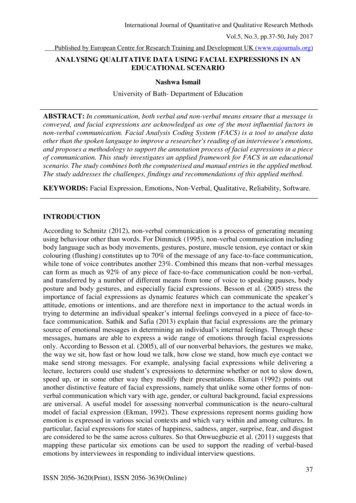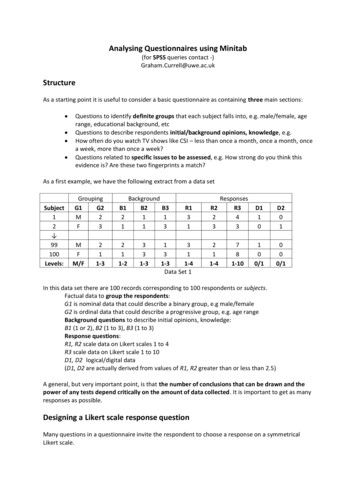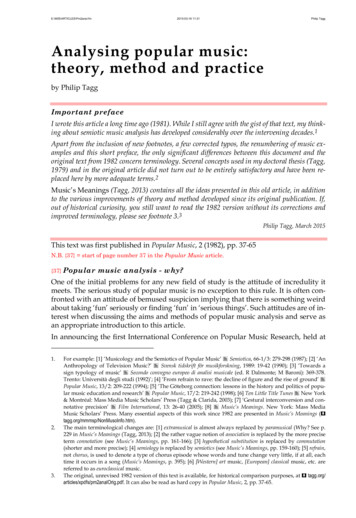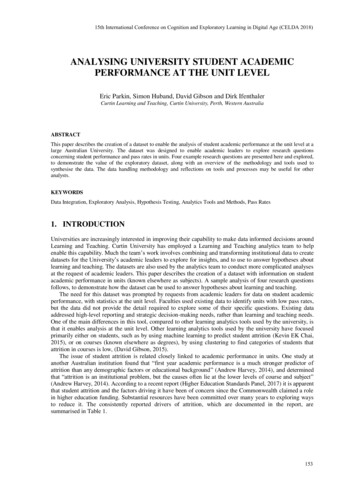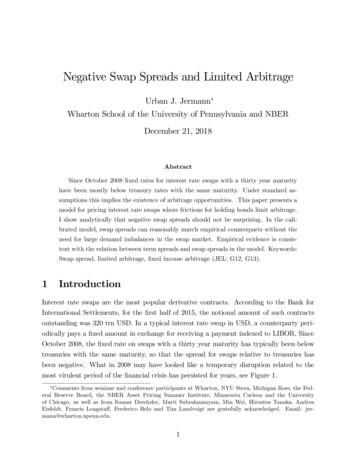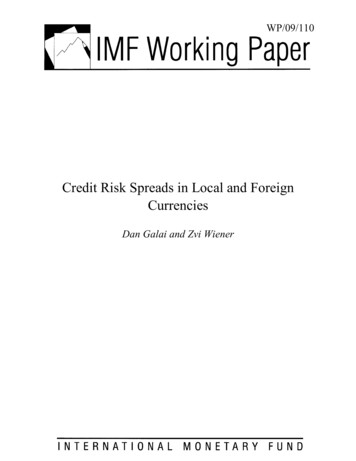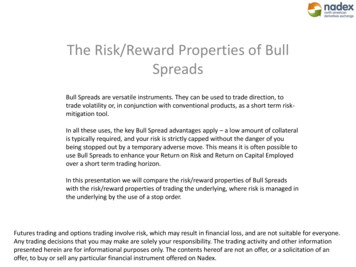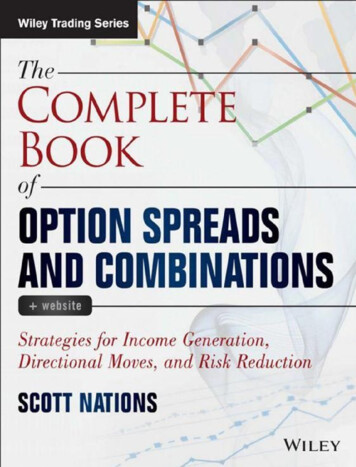
Transcription
Working Paper Series 25 2017Analysing Cross-Currency Basis SpreadsThis paper studies the drivers behind the EUR/USD basis swapspreads widening.Jaroslav BaranEuropean Stability MechanismJiří WitzanyUniversity of Economics, PragueDisclaimerThis Working Paper should not be reported as representing the views of the ESM.The views expressed in this Working Paper are those of the author(s) and do notnecessarily represent those of the ESM or ESM policy.
Working Paper Series 25 2017Analysing Cross-Currency Basis SpreadsJaroslav Baran1 European Stability MechanismJiří Witzany2 University of Economics, PragueAbstractThis paper investigates the drivers of cross-currency basis spreads, which were historically close to zero buthave widened significantly since the start of the financial crisis. Credit and liquidity risk, as well as supply anddemand have often been cited as general factors driving cross-currency basis spreads, however, these spreadsmay widen beyond what is normally explained by such variables. We suggest market proxies for EUR/USD basisswap spread drivers and build a multiple regression and cointegration model to explain their significance duringthree different historical periods of basis widening. The most important drivers of the cross-currency basisspreads appear to be short- and medium-term EU financial sector credit risk indicators, and to a slightly lesserextent, short- and medium-term US financial sector credit risk indicators. Another important driver is marketvolatility for the short-end basis spread, and the EUR/USD exchange rate for the medium term basis spread, andto a lesser extent, the Fed/ECB balance sheet ratio.Keywords: Cross-currency swap, basis spread, overnight indexed swap, cointegration, arbitrageJEL codes: D53, G01, C311 European Stability Mechanism; j.baran@esm.europa.eu2 University of Economics, Faculty of Finance and Accounting, Department of Banking and Insurance, Prague, Czech Republic;witzanyj@vse.cz. The research has been supported by the Czech Science Foundation Grant P402/12/G097 Dynamical Models inEconomicsDisclaimerThis Working Paper should not be reported as representing the views of the ESM. The viewsexpressed in this Working Paper are those of the author(s) and do not necessarily represent thoseof the ESM or ESM policy.No responsibility or liability is accepted by the ESM in relation to the accuracy or completeness ofthe information, including any data sets, presented in this Working Paper. European Stability Mechanism, 2017 All rights reserved. Any reproduction, publication and reprint in the form of adifferent publication, whether printed or produced electronically, in whole or in part, is permitted only with the explicit writtenauthorisation of the European Stability Mechanism.ISSN 2443-5503ISBN 978-92-95085-40-4doi:10.2852/01352EU catalog number DW-AB-17-004-EN-N
Analysing Cross-Currency Basis SpreadsJaroslav Baran1, Jiří Witzany21. IntroductionCross-currency basis swaps (CCS) have been for some years showing an interesting phenomenonof significantly negative (or positive) cross-currency basis spread to a floating rate of one currencyvs. the other (Figure 1). CCS basis spreads were historically close to zero (apart from bid-askspreads), based on the assumption of banks’ continuous access to interbank market financing atIBOR rates. This assumption was widely questioned when basis spreads significantly widened in2007 and practically became an independent market risk factor. The existence of the basis hasbeen since then often associated with a deviation from the covered interest rate parity (CIP). Inparticular, the assumptions of the CIP, such as no restrictions to investing in the domestic orforeign market, and that the domestic and foreign interest rates roughly reflect the same risk,thus needed to be questioned. Identifying the drivers behind the basis and their relativeimportance offers more clarity on the CIP, helps to assess the fair value of the basis, or helps toproject its future direction. In this paper, we discuss these drivers; in particular, we take a closerlook at how credit and liquidity risk of underlying money market rates in two currencies, anddemand and supply imbalances influence cross-currency basis swap spreads, and we discussarbitrage-free boundaries in cross-currency funding and investing. We focus on the most liquidcurrency pair, the EUR/USD, and review historical episodes of EUR/USD basis. The outcome ofthis discussion leads to identifying the drivers, the market variables, changes of which reasonablycapture changes in the EUR/USD basis. We then use them as regressors in the multiple regressionmodel and cointegration analysis to explain their importance during three relevant historicalperiods of basis widening on the short end (3 months), and medium part (5 years) of the EUR/USDbasis curve.1European Stability Mechanism, j.baran@esm.europa.euUniversity of Economics, Faculty of Finance and Accounting, Department of Banking and Insurance, Prague, CzechRepublic, witzanyj@vse.cz. The research has been supported by the Czech Science Foundation GrantP402/12/G097 Dynamical Models in Economics.We thank A. Erce, L. Ricci, D. Clancy, G. Cheng and seminar participants at the European Stability Mechanism fortheir helpful suggestions and discussions.21
Figure 1. 5-year cross-currency basis swap spread vs. major currencies (3M USD LIBOR vs. 3MEuribor/AUD 3M Bank Bill/3M YEN LIBOR/GBP 3M Libor spread) since 2005. Source: Bloomberg2. Literature reviewA float-to-float cross-currency basis swap is a swap that exchanges principal and periodic interestpayments based on two money market reference rates in two different currencies. The exchangerate used to fix the initial and the final principal amount is determined at inception. These arethe most commonly used cross-currency swaps and allow counterparties to temporarily transferassets or liabilities in one currency into another currency. A cross-currency basis spread thusrepresents the costs associated with temporary swapping of two currencies. The mechanics ofcurrency swaps are well explained e.g. in Baba et al. (2008b). Money market reference rates (i.e.,IBOR rates) in different currencies reflect different credit and liquidity risk, which are partlytranslated into a spread over one leg of the cross-currency basis swap (see Figure 2). The shapeof the basis spread term structure varies over time.2
Figure 2. Term structure of CCS spreads of 3M Euribor vs 3M USD Libor, 3M Pribor vs 3MEuribor, and 3M AUD Bank Bill vs 3M USD Libor as at 2 June 2017. Source: BloombergThe existence of basis swap spreads itself leads to discrepancies with respect to thisinterpretation. According to Chang and Schlogl (2012), basis swap spreads are inconsistent witha classical arbitrage argument between the spot and forward markets. In Section 3 we discussthis arbitrage argument in a slightly stricter sense in a setting where entities borrow at a risky(unsecured) rate while invest at a risk-free rate. From the valuation point of view, Bianchetti andCarlicchi (2012) argue that basis spreads are consistent with an arbitrage-free market, with theconsequence that the valuation of related derivatives needs multiple curve input for estimatingforward rates and discounting future cash flows. In fact, when we change the discount curve, wechange the market value of the derivative. This has led to a reassessment of the one curveconcept (using one curve to both estimate the forward rates and to discount future cash flows)and to the introduction and adoption of multiple valuation curves.Although the literature on cross-currency basis has been somewhat limited in the past, severalpapers have been recently published explaining the issue mostly in the context of a deviationfrom the CIP3. Since then, the topic has been attracting increasing attention with researchersstudying the causes of CIP violations and discussing whether these violations create arbitrageopportunities or one should rather question the underlying CIP assumptions.For example, Du et al. (2016) confirm that credit risk and transaction costs do not fully explainlarge and persistent deviations from the CIP, and they are rather caused by inefficient financialintermediation and imbalances between demand and supply across currencies. Borio et al. (2016)estimate that CIP violations across major currencies reflect demand for currency hedges whilethe arising arbitrage opportunities were limited due to risk limits and balance sheet constraints3In fact, quoted basis spread bs largely captures “CIP violations” and modifies the original CIP equation to𝐹(1 𝑟𝑓 ) (1 (𝑟𝑑 𝑏𝑠)), where 𝑟𝑓 is the foreign interbank rate, 𝑟𝑑 is the domestic interbank rate, F is the𝑆forward exchange rate, and S is the spot exchange rate, for simplicity, omitting time to maturity.3
of market participants. Arai et al. (2016) study the USD/JPY basis and argue that its recentwidening has been caused by demand for USD, reduced market-making abilities, and lower USDsupply from the foreign official sector.Earlier works point out interbank market distress and demand for USD. Ando (2012) concludesthat the volatility of basis swap spreads is caused by the stress in the unsecured interbank moneymarket, although such stress does not explain the whole spread. Ivashina et al. (2012) present amodel in which European banks cut their dollar lending more than euro lending in response totheir credit quality deterioration. European banks are forced to turn to the secured FX swapmarket but limited demand on the other side also makes the synthetic secured dollar borrowingexpensive, leading banks to cut their dollar lending. This model has been successfully tested inthe context of the recent financial crisis. Baba et al. (2008) analysed spillover effects from moneymarkets into FX swap markets, arguing that the shortage of dollar funding of non-US bankscaused large deviations from covered interest parity (CIP). Authors also tested Granger causalitybetween FX swap quotes and cross-currency basis swap (CCS) quotes and found that during thecrisis period, deviations from CIP were spread from the FX swap market to the longer term CCSmarket.We also note some of the earlier related works that study the determinants of interest rate swap(IRS) spreads (i.e. the difference between government bond yields and swap rates) since factorsinfluencing CCS spreads could be similar to factors influencing IRS spreads in one currency,namely credit risk and bond supply. For example, Cortes (2006) uses principal componentanalysis to find that the term structure of swap spreads in different markets moves together andis upward sloping in the two to ten-year part of the curve, due to existence of a default termpremium and global expectations of government bond issuance (the higher the net borrowing,the steeper the yield curve). Huang et al. (2002) confirm that liquidity has a significant negativeeffect on swap spreads (swap spreads fall with increased supply and a steeper Treasury curve).We will presently analyse cross-currency basis swap spreads from different angles. In the nextsection, we discuss credit and liquidity risk, and supply and demand pressure of one currencyversus another. We revive the work of Ando (2012) with more recent data to constructboundaries within which there should be no arbitrage opportunity. However, by testing theseboundaries, we reconfirm that supply and demand imbalances may push basis spreads outsidethese boundaries, creating arbitrage opportunities for those market participants who are able toraise unsecured funding at interbank rates in one currency and swap it into another currency.Such episodes can take place across a number of currencies, however, we focus and illustrate iton the most actively traded pair, the EUR/USD basis swap.We then build a multiple regression and a cointegration model to explain the drivers of EUR/USDbasis swap spreads and their individual importance during three different relevant historical4
periods. As regressors, we use variables that serve as a proxy for short- and medium-term creditrisk, liquidity conditions, and demand and supply. We show that although an increase ininterbank risk in both euro and US dollar caused a widening of EUR/USD basis swap spreads, theinterbank risk only does not fully capture the level of these spreads. The residual term may bepartially assigned to supply and demand imbalances, which may arise and persist over a longerperiod of time.3. Cross-currency basis spread determinantsCredit, liquidity, and supply and demand forces all influence cross-currency basis spreads. Thesespreads are influenced by the ability and conditions of funding directly in a single currency, andthus by supply and demand for cross-currency financing.CCS are used to hedge currency risk that arises if an entity decides to fund or invest in a foreigncurrency. A domestic entity uses CCS to eithera) fund domestic assets with foreign currency borrowings and use the demand sideof the CCS swap market (a demand for domestic currency) orb) fund foreign currency assets with domestic currency borrowings and use thesupply side of the CCS swap market (a supply of domestic currency).For example, a) can be used by corporates issuing bonds in foreign currency and swapping theproceeds into domestic currency while b) is often used by banks when they lack a deposit basein the foreign currency and need to swap deposits in their domestic currency.Both sides are in balance if each of them is able to meet the other side of the trade. A foreignentity thus in case of a) issues debt in domestic currency and is a seller of the domestic currencyto domestic banks in the CCS market or b) buys domestic assets and is a buyer of a domesticcurrency from domestic banks in the CCS swap market. If the sides of this equation are unequalthen the imbalance causes volatility and puts pressure on the CCS basis spreads.Short end of the cu
model in which European banks cut their dollar lending more than euro lending in response to their credit quality deterioration. European banks are forced to turn to the secured FX swap market but limited demand on the other side also makes the synthetic secured dollar borrowing expensive, leading banks to cut their dollar lending. This model has been successfully tested inFile Size: 1MBPage Count: 29Explore furtherCross-Currency Swap Definition and Examplewww.investopedia.comUnderstanding dollar cross-currency basis Systemic Risk .www.sr-sv.comCovered interest parity lost: understanding the cross .www.bis.orgHow to value a cross-currency swap Zanders Treasury .zanders.euRecent trends in cross-currency basiswww.bis.orgRecommended to you based on what's popular Feedback

